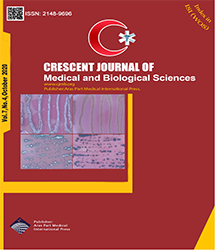
| Original Article | |
| Dietary Pattern-Based Differences in the Associations Between Weight Control, Bone Mineral Density, and the Risk of Fracture Among Iranian Postmenopausal Women With Osteoporosis: An Application of Theory of Planned Behavior | |
| Haidar Nadrian1, Hossein Hajizadeh2, Farhang Soltani Bejestani3, Pouria SefidMooye Azar4, Manouchehr Teymouri5 | |
| 11Department of Health Education and Promotion, Faculty of Health, Tabriz University of Medical Sciences, Tabriz, Iran 2Nutrition Research Center, Department of Nutrition, Faculty of Nutrition and Food Sciences, Tabriz University of Medical Sciences, Tabriz, Iran 3Department of Rheumatology, Faculty of Medicine, Gonabad University of Medical Sciences, Gonabad, Iran 4Department of Nutrition, Faculty of Nutrition and Food Sciences, Tabriz University of Medical Sciences, Tabriz, Iran 5Addiction and Behavioral Sciences Research Center, School of Medicine, North Khorasan University of Medical Sciences, Bojnurd, Iran |
|
|
CJMB 2020; 7: 503-509 Viewed : 3882 times Downloaded : 3193 times. Keywords : Weight control, Osteoporosis, Theory of planned behavior, Dietary patterns, Risk of fracture, Bone mineral density |
|
| Full Text(PDF) | Related Articles | |
| Abstract | |
Objectives: The aim of the present study was to investigate the relationships between cognitive factors, weight control behavior, bone mineral density (BMD), and the risk of bone fracture by the dietary pattern among Iranian postmenopausal women with osteoporosis. Materials and Methods: In this cross-sectional study (2017), 240 postmenopausal women with osteoporosis referring to two densitometry clinics in Tabriz (Iran) were recruited to participate in the study using a convenience sampling technique. Then, nutrition survey, BMD, the risk of bone fracture, weight control behavior, and a framework-based weight control behavior questionnaire (Weight-CuRB) were applied to collect data. Results: Using factor analysis, three distinct dietary patterns were identified, including healthy, mixed, and western patterns, which accounted for 24.24% of the total variance in food intake. After adjustment for cognitive and socio-demographic variables, patients with a western dietary pattern and no control on weight showed the increased risk of major osteoporotic (odds ratio [OR]: 4.82, CI: 2.02-11.45, P = 0.000) and hip (OR: 3.13, CI: 1.36-7.19, P = 0.007) fractures (P<0.001). In addition, in the subjects with western dietary pattern and no control over their weight, results showed an increased risk of low BMD (OR: 0.451, CI: 0.199-1.042, P = 0.044). Conclusions: In general, the increased intake of fruits, nuts, the vegetable oil in a healthy dietary pattern, and adoption of appropriate weight control behaviors may reduce the risk of bone fracture in postmenopausal women with osteoporosis. Accordingly, health practitioners and healthcare providers should consider weight control in their risk assessment of bone fracture in postmenopausal women with osteoporosis. |
Cite By, Google Scholar
Google Scholar
PubMed
Online Submission System
 CJMB ENDNOTE ® Style
CJMB ENDNOTE ® Style
 Tutorials
Tutorials
 Publication Charge
Medical and Biological Research Center
About Journal
Publication Charge
Medical and Biological Research Center
About Journal
Aras Part Medical International Press Editor-in-Chief
Arash Khaki
Deputy Editor
Zafer Akan


















